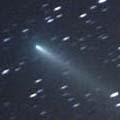
|
It reached to 5 mag at best in early May at the remarkable approach to the earth, when it became double naked eye comets with the component C around the zenith. Now it is going away from the earth and fading. It has already faded down to 8.5 mag (June 10, Willian Souza). But the apparent distance between the two components is reduced and two bright comets become to be in the same field. It still locates high in the Southern Hemisphere. But in the Northern Hemisphere, it locates extremely low in the morning in June. It will be getting higher gradually after July, however, it will be fading rapidly. Now it is a bit fainter than the component C. But it is still close to the sun. So another another outburst may occur due to the nuclear split.
Date(TT) R.A. (2000) Decl. Delta r Elong. m1 Best Time(A, h)
June 17 1 39.10 -11 7.8 0.288 0.949 68 8.4 5:35 (243, 50)
June 24 1 51.87 -11 48.8 0.339 0.968 72 8.9 5:37 (239, 53)
|
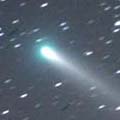
|
It reached to 6 mag at best in early May at the remarkable approach to the earth, when it became double naked eye comets with the component B around the zenith. Now it is going away from the earth and fading. It has already faded down to 7.8 mag (June 10, Willian Souza). But the apparent distance between the two components is reduced and two bright comets become to be in the same field. It still locates high in the Southern Hemisphere. But in the Northern Hemisphere, it locates extremely low in the morning in June. It will be getting higher gradually after July, however, it will be fading rapidly.
Date(TT) R.A. (2000) Decl. Delta r Elong. m1 Best Time(A, h)
June 17 1 34.95 -10 49.3 0.309 0.951 69 8.5 5:35 (241, 50)
June 24 1 48.76 -11 20.5 0.360 0.972 72 8.9 5:37 (237, 53)
|
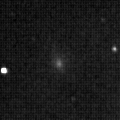
|
The condition is worst in this time, not visible in the Northern Hemisphere at all. It was observed in the Southern Hemisphere as 11.4 mag on June 6, as bright as expected (Michael Mattiazzo). However, it will be unobservable even in the Southern Hemisphere soon. In this appearance, the comet will never be observable again.
Date(TT) R.A. (2000) Decl. Delta r Elong. m1 Best Time(A, h)
June 17 3 55.65 18 29.9 1.333 0.595 24 9.9 5:35 (243, 5)
June 24 4 48.07 21 3.8 1.392 0.545 19 8.8 5:37 (245, -1)
|

|
It brightened much more rapidly than expected after late April. Now it reaches to 9.5 mag (June 15, Willian Souza). It becomes brightest in June and will start fading after July. But it keeps observable in the evening until autumn when it becomes too faint to see. It keeps locating around 30 degree high. Great outburst over 6 mag has occured always in recent appearances in 1995 and 2001. So it may brighten much more after this.
Date(TT) R.A. (2000) Decl. Delta r Elong. m1 Best Time(A, h)
June 17 10 16.33 20 32.2 0.984 1.050 63 9.5 18:25 (151, 29)
June 24 10 48.44 18 15.3 0.966 1.061 64 9.6 18:27 (150, 31)
|

|
Now it is brightest and reached to 11.0 mag (June 15, Willian Souza). It keeps 11-12 mag until July. The condition is best beucase it is almost at opposition at the perihelion passage. However, it keeps very low, only 13-20 deg high until September in the Northern Hemisphere. When it gets higher again, it will be fainter than 14 mag, too faint to see visually.
Date(TT) R.A. (2000) Decl. Delta r Elong. m1 Best Time(A, h)
June 17 19 36.45 -36 14.2 0.594 1.565 151 11.8 1:57 ( 0, 89)
June 24 19 38.93 -37 58.6 0.587 1.571 156 11.9 1:32 ( 0, 87)
|

|
It had been observed at 10 mag in the evening sky from winter to spring. But now it is not observable. It will appear in the morning sky again in late August at 13.5 mag. It will come to locate high in October, then it will be visible visually again at 14 mag.
Date(TT) R.A. (2000) Decl. Delta r Elong. m1 Best Time(A, h)
June 17 6 6.81 34 34.5 3.136 2.155 12 12.2 18:25 (120,-19)
June 24 6 25.74 34 23.4 3.206 2.219 11 12.4 18:27 (118,-21)
|

|
Now it is 12.8 mag (June 5, Juan Jose Gonzalez). Diffuse visually. It had been originally expected to reach to 9 mag at best. However, the brightness evolution had been very slow, and actually it is much fainter than originally expected. But with a large telescope, it is still bright and enjoyable. It will be observable in good condition after this until autumn. It will be visible bright as 12 mag for a while.
Date(TT) R.A. (2000) Decl. Delta r Elong. m1 Best Time(A, h)
June 17 16 55.02 29 36.6 1.582 2.328 125 12.8 23:10 (180, 25)
June 24 16 31.90 30 55.8 1.706 2.391 120 13.0 22:20 (180, 24)
|

|
New comet just discovered on June 14. It is bright as 13.4 mag and visible visually (June 16, Willian Souza). In the Northern Hemisphere, it locates rather low in the evening. In the Southern Hemisphere, it locates high. It will be observable at 13 mag for a long time after this.
Date(TT) R.A. (2000) Decl. Delta r Elong. m1 Best Time(A, h)
June 17 14 37.16 -36 42.6 1.848 2.694 138 13.1 20:54 ( 0, 89)
June 24 14 26.65 -32 25.5 1.864 2.639 130 13.1 20:16 (180, 87)
|
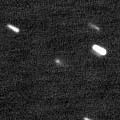
|
It was 15.0 mag on June 13 (Giovanni Sostero and Ernesto Guido), brightening as expected. It will be getting higher and brightening rapidly after this. It will become visible visually soon. It will reach to 8.5 mag from autumn to winter, and observable in its best condition. It keeps 14 mag still in 2007 April, so it keeps visible visually for a long time.
Date(TT) R.A. (2000) Decl. Delta r Elong. m1 Best Time(A, h)
June 17 23 53.06 6 49.7 2.058 2.206 84 14.0 5:35 (194, 47)
June 24 0 4.13 8 0.3 1.946 2.166 88 13.6 5:37 (187, 47)
|
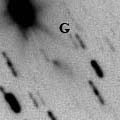
|
The components G, R, and other several fragments became bright up to 12-14 mag and visible visually from April to early May. However, all fragments were reported so faint after mid May. They still locate high in the Southern Hemisphere. But in the Northern Hemisphere, they are already extremely low in the morning. However, it is rather close to the earth still now, so some fragments may brighten up to 13-14 mag again after this.
Date(TT) R.A. (2000) Decl. Delta r Elong. m1 Best Time(A, h)
June 17 1 40.09 -11 14.6 0.281 0.948 68 13.8 5:35 (243, 50)
June 24 1 52.54 -11 59.2 0.332 0.968 72 14.4 5:37 (239, 53)
|

|
It did not brighten so frequently in 2005. But it was often bright as 12-13 mag in early 2006. Now it is not observable. It will appear again at dawn in July. Then it will be observable in good condition in autumn and winter.
Date(TT) R.A. (2000) Decl. Delta r Elong. m1 Best Time(A, h)
June 17 3 34.44 27 30.1 6.686 5.816 28 13.9 5:35 (233, 3)
June 24 3 40.15 27 51.7 6.633 5.818 33 13.8 5:37 (230, 6)
|

|
It has been visible at 13.5 mag since last October. Small and strongly condensed. It kept observable in good condition for a long time, but it will be getting lower in the evening, and will be too low to observe in July. However, it will be observable in good condition again at 14.5 mag in next winter.
Date(TT) R.A. (2000) Decl. Delta r Elong. m1 Best Time(A, h)
June 17 10 14.94 41 12.6 5.665 5.216 59 14.0 18:25 (159, 10)
June 24 10 21.08 40 11.4 5.741 5.221 54 14.1 18:27 (155, 9)
|

|
It reached to 5.2 mag at best in late February and early March. It is fading rapidly, however, it was still bright as 12.2 mag on May 25 (Juan Jose Gonzalez), brighter than this ephemeris. But now it is very diffuse. In the Northern Hemisphere, it keeps observable in good condition until it becomes too faint to see.
Date(TT) R.A. (2000) Decl. Delta r Elong. m1 Best Time(A, h)
June 17 2 37.92 70 19.5 2.616 2.178 53 14.6 5:35 (196,-21)
June 24 2 49.37 71 21.6 2.690 2.277 55 14.9 5:37 (194,-21)
|

|
Although it was not observed in its last return in 1999, it will be observable in good condition after the periheliion passage in this return. It will reach to 14.5 mag from June to August. Now it is appearing in the morning sky, however, it has not been recovered yet.
Date(TT) R.A. (2000) Decl. Delta r Elong. m1 Best Time(A, h)
June 17 1 27.39 18 15.8 2.296 1.975 58 14.7 5:35 (216, 28)
June 24 1 39.88 20 50.8 2.240 1.979 62 14.6 5:37 (211, 28)
|

|
In 2005 spring, it reached to 14 mag and became visible visually as 13.8 mag (July 8, Reinder J. Bouma). In 2006, it will be the same condition and brightness in summer again. Somewhat low in the south. But it will reach to 14 mag.
Date(TT) R.A. (2000) Decl. Delta r Elong. m1 Best Time(A, h)
June 17 22 45.36 -18 50.6 2.672 3.162 109 15.1 5:05 (180, 74)
June 24 22 47.86 -19 0.5 2.596 3.172 115 15.1 4:40 (180, 74)
|

|
It is outside of Jupiter's orbit, so it keeps observable for a long time. In 2006, it is still faint and locating somewhat low. But in 2007 and 2008, it is expected to be bright as 14.5-15 mag. It will locate high at that time, so it may be visible visually.
Date(TT) R.A. (2000) Decl. Delta r Elong. m1 Best Time(A, h)
June 17 20 0.20 -24 35.1 6.062 6.946 148 15.9 2:21 (180, 80)
June 24 19 53.88 -24 32.6 5.975 6.918 156 15.9 1:47 (180, 80)
|

|
It has been lost since its discovery in 1986. The condition is good in this return. In calculation, it will be 14 mag from autumn to winter. However, it was probably in outburst and brightened unexpectedly at the discovery. So it can be much fainer than this ephemeris actually. In the Northern Hemisphere, it keeps observable until it fades out in next spring.
Date(TT) R.A. (2000) Decl. Delta r Elong. m1 Best Time(A, h)
June 17 18 6.93 -23 57.6 1.158 2.171 173 16.4 0:28 (180, 79)
June 24 17 59.47 -23 52.0 1.107 2.123 177 16.1 23:48 (180, 79)
|

|
It was fantastic, so bright as 3.5 mag, so large as 30 arcmin, locating high overhead at its best time in early 2004 January. Then it has been getting fainter gradually, and become already too faint to see visually. However, it is still bright as 15.8 mag by CCD observations (Mar. 30, Katsumi Yoshimoto). It keeps observable until October when it becomes fainter than 18 mag.
Date(TT) R.A. (2000) Decl. Delta r Elong. m1 Best Time(A, h)
June 17 16 18.44 2 48.3 5.150 6.028 147 16.4 22:35 (180, 52)
June 24 16 14.86 2 30.7 5.258 6.090 141 16.4 22:04 (180, 53)
|

|
It is unexpectedly bright as 15.5 mag on Apr. 2 (Ken-ichi Kadota). But it keeps very low until June. It will be getting higher after it starts fading. However, it has ever become a naked eye object in outburst, so observations are encouraged.
Date(TT) R.A. (2000) Decl. Delta r Elong. m1 Best Time(A, h)
June 17 23 58.46 -6 58.1 1.675 1.940 88 16.4 5:35 (202, 60)
June 24 0 8.09 -6 47.9 1.638 1.974 93 16.5 5:37 (192, 61)
|

|
It was 15.8 mag on Feb. 9 (Ken-ichi Kadota). It will be observable in good condition as 16 mag for a long time until next spring. It was too faint to see visually, fainter than 13.9 mag (Mar. 31, Seiichi Yoshida).
Date(TT) R.A. (2000) Decl. Delta r Elong. m1 Best Time(A, h)
June 17 10 54.10 53 12.9 5.421 5.069 64 16.5 18:25 (169, 0)
June 24 11 0.94 51 57.1 5.489 5.079 61 16.6 18:27 (166, 1)
|
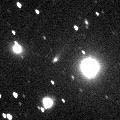
|
In 2005, it had been observed at 16 mag by CCD, or 14 mag visually, in spring and summer. It will be observable again at 16.5 mag in spring and summer in 2006. But the altitude will be somewhat lower than in 2005.
Date(TT) R.A. (2000) Decl. Delta r Elong. m1 Best Time(A, h)
June 17 19 24.47 -12 49.3 3.195 4.128 153 16.6 1:45 (180, 68)
June 24 19 18.12 -14 20.8 3.179 4.156 161 16.7 1:12 (180, 69)
|
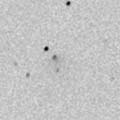
|
It is outside of Jupiter's orbit. So it keeps 16.5-17 mag for a long time. Because it moves in the northern sky, it keeps locating high and observable in good condition until 2006 summer.
Date(TT) R.A. (2000) Decl. Delta r Elong. m1 Best Time(A, h)
June 17 13 19.31 61 50.0 6.947 6.849 80 16.8 19:37 (180, -7)
June 24 13 17.33 60 31.3 7.001 6.855 77 16.9 19:07 (180, -5)
|

|
Peculiar asteroid moving along a comet-like orbit. It will reach to 14 mag in next January. It keeps observable in good condition after this while getting brighter rapidly. It may turn to be a comet after this.
Date(TT) R.A. (2000) Decl. Delta r Elong. m1 Best Time(A, h)
June 17 22 46.09 1 51.8 2.385 2.776 101 17.0 5:06 (180, 53)
June 24 22 48.63 3 29.3 2.231 2.710 107 16.8 4:41 (180, 52)
|

|
It was 16.0 mag on Mar. 13 (Ken-ichi Kadota). It kept 16-16.5 mag for about one year from early 2005. It had been locating somewhat low for a while, but it will be higher after this. It keeps 17 mag until autumn when the condition becomes good.
Date(TT) R.A. (2000) Decl. Delta r Elong. m1 Best Time(A, h)
June 17 0 55.89 54 21.4 3.769 3.384 60 16.9 5:35 (194, -2)
June 24 1 0.74 54 26.5 3.729 3.405 63 16.9 5:37 (191, -1)
|

|
It is getting higher in the morning sky. It keeps observable at 17 mag in good condition after this until October.
Date(TT) R.A. (2000) Decl. Delta r Elong. m1 Best Time(A, h)
June 17 23 36.09 -12 8.1 2.123 2.445 95 17.2 5:35 (193, 67)
June 24 23 42.64 -11 14.6 2.055 2.455 100 17.2 5:35 (180, 66)
|

|
It had been an extremely faint Centaur asteroid until 2004, fainter than 21 mag. However, it brightened up to 17.5 mag on 2005 Dec. 30, and a coma was observed, then it was revealed to be a comet. It brightened furthermore, 14.8 mag on Jan. 7 (Ken-ichi Kadota). It was also visible visually at 14.4 mag (Jan. 8, Seiichi Yoshida). It still keeps bright as 15.7 mag on Apr. 16 (Mitsunori Tsumura). Now the condensation of the outburst looks separatedly from the nucleus. Because it is a temporary brightening in outburst, it will return to be so faint as 21 mag in the near future. It will pass the perihelion in 2015. The heliocentric distance reduces down to 5.9 A.U., but it will be 17 mag at best. However, another outburst may happen again in the future.
Date(TT) R.A. (2000) Decl. Delta r Elong. m1 Best Time(A, h)
June 17 12 56.88 -3 59.0 12.403 12.770 109 17.2 19:15 (180, 59)
June 24 12 56.76 -3 58.8 12.502 12.758 102 17.4 18:47 (180, 59)
|

|
It was observed at 17 mag in 2005 summer. It will reach to 17 mag again in 2006 summer.
Date(TT) R.A. (2000) Decl. Delta r Elong. m1 Best Time(A, h)
June 17 22 50.28 -8 12.9 2.836 3.247 104 17.4 5:10 (180, 63)
June 24 22 52.96 -8 11.3 2.751 3.255 110 17.3 4:45 (180, 63)
|

|
It is outside of Jupiter's orbit. So it keeps 16.5-17.5 mag for a long time until 2008. In 2006, it keeps observable in good condition until November.
Date(TT) R.A. (2000) Decl. Delta r Elong. m1 Best Time(A, h)
June 17 22 7.45 -17 3.8 5.949 6.483 117 17.5 4:28 (180, 72)
June 24 22 3.71 -16 51.8 5.824 6.462 125 17.4 3:56 (180, 72)
|
|
![]()
 117P/Helin-Roman-Alu 1
117P/Helin-Roman-Alu 1 C/2005 L3 ( McNaught )
C/2005 L3 ( McNaught ) D/1986 W1 ( Lovas 2 )
D/1986 W1 ( Lovas 2 ) C/2004 Q2 ( Machholz )
C/2004 Q2 ( Machholz ) 98P/Takamizawa
98P/Takamizawa C/2004 D1 ( NEAT )
C/2004 D1 ( NEAT ) C/2005 K1 ( Skiff )
C/2005 K1 ( Skiff ) C/2002 VQ94 ( LINEAR )
C/2002 VQ94 ( LINEAR ) 2006 HR30
2006 HR30 C/2005 B1 ( Christensen )
C/2005 B1 ( Christensen ) P/2006 H1 ( McNaught )
P/2006 H1 ( McNaught ) 174P/(60558) 2000 EC98 ( Echeclus )
174P/(60558) 2000 EC98 ( Echeclus ) P/2005 L1 ( McNaught )
P/2005 L1 ( McNaught ) C/2005 S4 ( McNaught )
C/2005 S4 ( McNaught )![]()




















